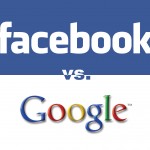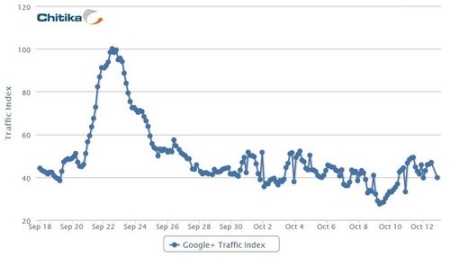In response to Elaine Cheung’s blog post on: Business Profiles on Google+
Elaine recently wrote that it has become difficult for brands to stand out on Facebook and
Twitter, and that they should use Google+ to target their viewers. I think this is the wrong approach. Google+’s 1269% gain in market share has be entirely erased as of Oct. 10th and competitors have been able to easily copy its features.
What went wrong? Google+ reached 40 million users in its first 3 months alone (which outpaced Facebook and Twitters start up numbers). However, “”it forms only 4% of Google users, the early adopters and the curious minority,” Collins Stewart analyst Mayuresh Masurekar wrote in a note. Google Plus needs to have 100 million active users to compete with Facebook, however, Google+ does not have the sort of time sinks Facebook does. Software developer, Steve Yegge, claimed: “Google+ is a knee-jerk reaction, a study in short-term thinking, predicated on the incorrect notion that Facebook is successful because they built a great product. But that’s not why they are successful. Facebook is successful because they built an entire constellation of products by allowing other people to do the work. So Facebook is different for everyone. Some people spend all their time on Mafia Wars. Some spend all their time on Farmville. There are hundreds or maybe thousands of different high-quality time sinks available, so there’s something there for everyone”.
have the sort of time sinks Facebook does. Software developer, Steve Yegge, claimed: “Google+ is a knee-jerk reaction, a study in short-term thinking, predicated on the incorrect notion that Facebook is successful because they built a great product. But that’s not why they are successful. Facebook is successful because they built an entire constellation of products by allowing other people to do the work. So Facebook is different for everyone. Some people spend all their time on Mafia Wars. Some spend all their time on Farmville. There are hundreds or maybe thousands of different high-quality time sinks available, so there’s something there for everyone”.
Instead of investing in Google+ business profiles, companies need to do more market research to better utilize Facebook and Twitter. Companies need to pinpoint who their target market is on Facebook/Twitter by analyzing and how much time is spent and what each demographic does on the site. The company can then create targeted campaigns at the most active demographics. Then companies will be able to stand out.


I think integrating social feature into search engine seems to be a bad idea. Because users and their friends can’t discover great content unless they perform search queries in Google. In contrast, Twitter and Facebook users can check out shared contents directly via a links which are more convenient.